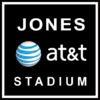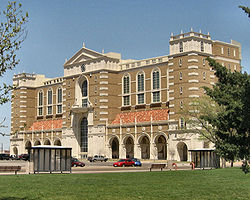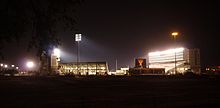- Jones AT&T Stadium
-
Jones AT&T Stadium "The Jones"[1] 

View of the West Side Stadium BuildingFormer names Jones SBC Stadium
(2000–2006)
Clifford B. & Audrey Jones Stadium (1947–2000)Location Drive of Champions
Lubbock, Texas 79409
United StatesCoordinates 33°35′28″N 101°52′22″W / 33.59111°N 101.87278°WCoordinates: 33°35′28″N 101°52′22″W / 33.59111°N 101.87278°W Broke ground 1947 Opened November 29, 1947[2] Renovated 2003, 2009–2010 Expanded 1959, 1972, 2003, 2005, 2010 Owner Texas Tech University Operator Texas Tech University Surface FieldTurf (2006–present)
AstroTurf (1972–2005)
Natural grass (1947–1971)Construction cost $400,000
($3.93 million in 2011 dollars[3])Architect Ellerbe Becket (renovation)[4] Capacity 60,454 (2010-present)
58,930 (2009)
52,882 (2003-2008)
50,500 (1991-2002)
47,000 (1972-1990)
41,500 (1959-1971)
27,000 (1947-1958)Executive Suites 83[5] Record attendance See section below Tenants Texas Tech Red Raiders - NCAA (1947–present)
Coaches All-America Game (1970-1976)Jones AT&T Stadium (previously known as Clifford B. and Audrey Jones Stadium and Jones SBC Stadium) is an outdoor athletic stadium on the campus of Texas Tech University in Lubbock, Texas, United States. It is the home field of the Texas Tech Red Raiders football team of the Big 12 Conference.
Contents
History
Planning and funding
Clifford B. and Audrey Jones Stadium opened in 1947. The original seating capacity was 27,000.
Expansion
In 1959 the stadium's first expansion raised the seating to 41,500. The existing east stands were placed on railroad ties and moved 150 feet (46 m) further east, and the playing surface was lowered below street level, to accommodate the new lower bowl. It was expanded again in 1972 with new red, metal seats on the north side bringing capacity of 48,000.
Modernization
On November 17, 1999, the school announced a $20 million donation by SBC for construction of a new press box and west side club seating building to raise capacity to 52,882.
The stadium name was changed to Jones SBC Stadium in 2000 due to a naming rights agreement with SBC Communications,[1] which funded a large part of the stadium's West Stadium Club expansion. On April 6, 2006, the facility officially changed names again, this time to Jones AT&T Stadium as a result of SBC's merger with AT&T and adoption of AT&T as its new corporate name.[6]
In May 2009, it was announced an additional 6,100 seats would be added in the north-east and north-west end zones by mid-season.[7] The additional general admission seating was opened in the north end of the stadium on October 24, 2009, bringing capacity at that time to 58,930.[8] The new East Side Building expansion is complete, bringing the total amount of suites to 89 and seating capacity to 60,454.[9][10]
The largest renovation project to date was the $51.9 million, 175,000-square-foot (16,300 m2) press box that included luxury suites, club seating and decks for television cameras and the press. This added 2,000 seats and was completed during the 2003 season.
For 2006, the stadium was upgraded with a $2-million-dollar inner field wall that matches the traditional Texas Tech style brick façade. An inscribing of the Matador Song at the Double T in the north and south endzones was also added.
In February 2006, the university announced plans to add $60 million worth of upgrades including additional luxury suites, a 1,000-car parking garage, an upper deck, a facade on the east side of the stadium and more seating. The entire project was set to begin following the 2006 season but was cancelled.[11]
On August 7, 2008, the Texas Tech Board of Regents announced a $25 million expansion project.[12] The planned expansion will add a Spanish Renaissance-themed façade to the east side of the stadium. In addition to the improvements to the exterior of the facility, the expansion will add 1,000 general-admission seats, 550 club seats, and 26 suites.[13] Texas Tech allocated a total of $19 million to the expansion and added another $6 million through fund-raising initiatives.[14]
On November 20, 2008, university officials announced that the project's fundraising goal had been exceeded. Most of the money came from private donations, including a large contribution from AT&T and a $1M matching gift from Texas Tech System Board of Regents member, Larry Anders. A small amount of the funds will come from future ticket sales.[15] Groundbreaking ceremonies for the expansion took place on November 29, 2008.[16] Construction began following the 2008 season.[14]
In May 2009, the university confirmed that additional money raised in the initial fundraising would be going to expand the north endzone seating by an additional 6,100 seats. Overall from 1999 to 2009 the school has spent $84 million for ongoing renovation and expansion to the stadium and the football program. In doing so, seating capacity increased by about 10,000 seats to its current capacity of 60,454 seats.[9][10]
Features
 Double T scoreboard
Double T scoreboard
Scoreboard
Playing surface
The playing field runs in the traditional north-south configuration and sits at an elevation of 3,215 feet (980 m) above sea level.[17]
When Jones AT&T Stadium opened in 1947, the playing field featured a grass playing surface until it was replaced with AstroTurf in 1971. In 2006, FieldTurf replaced the AstroTurf playing field.
Seating and tickets
After numerous renovations and expansions, Jones AT&T Stadium currently seats 60,454. The capacity makes the stadium the 44th largest college football stadium and the third largest college football stadium in Texas (although Rice Stadium has a listed capacity of 47,000 covered seating in the endzone makes it expandable to 70,000[18]).
12,548 seats are designated for students between 13 sections.[19][20]
46,546 season tickets were sold for the 2010 season, surpassing the previous season ticket record of 30,092 that were purchased prior to the start of the 2008 season.[21]
For the 2011 season, season tickets in the stadium's bowl range from a maximum of $429, to as low as $189. Only the highest priced season-tickets include personal seat license fees, which range from a maximum of $300, to as low as $100. Twenty sections do not require a PSL. Donations to the Red Raider Club, a fundraising organisation for the athletic department, ranging from a maximum of $300, to as low as $100, also are required to purchase season tickets in twenty-two of the stadium sections. Season tickets in the stadium's club level are $649. Eleven stadium sections - do not require a seat-license fee or Red Raider Club donation.[22]
Stadium usage
Texas Tech Red Raiders
Main article: Texas Tech Red Raiders football“ Neither the biggest nor the loudest, Jones Stadium and its crowd helped the Raiders pull off recent upsets of Texas and Oklahoma. ” —Dave Curtis of Sporting News, [23]
The Texas Tech Red Raiders played their first game in Jones AT&T Stadium on November 29, 1947—a 14–6 win against the Hardin–Simmons Cowboys.[5] The Red Raiders have a posted a 330-156-13 (.673) record at Jones AT&T Stadium record through the 2010 season.[5] Through the 2010 season, in Jones AT&T Stadium, the Red Raiders have posted a record of 181–74.[5] The attendance record of 60,454, the capacity of the stadium, was set twice during the 2010 season against the Texas Longhorns and Oklahoma State Cowboys.[5] A 34-27 win over the Oklahoma Sooners on November 17, 2007, was the start of a 12 game winning streak, the longest Red Raider winning streak at Jones AT&T Stadium that lasted through October 24, 2009, with a 52-30 loss to Texas A&M Aggies. Texas Tech has gone undefeated at Jones AT&T Stadium 7 seasons, 1951, 1954, 1965, 1973, 1995, 2005, 2008.[5]
Coaches All-America Game
Main article: Coaches All-America GameThe Coaches All-America Game, a postseason college football all-star game that served as the concluding game of the college football season, was hosted at Jones AT&T Stadium from 1970-1975. The all-star game was sponsored by the American Football Coaches Association (AFCA) and profits from ticket sales and television rights went to fund AFCA scholarships. Prior to the Coaches All-America Game relocating to Lubbock, from 1961 to 1965, War Memorial Stadium in Buffalo, New York, served as host and prior to relocating to Lubbock due to attendance issues, Atlanta Stadium hosted the game from 1966 to 1969. Lubbock won the bid to host the game over newer stadiums in larger cities, Memorial Stadium in Memphis, Tennessee and San Diego Stadium in San Diego, after the AFCA was convinced that Lubbock's advantages as a college town without competing entertainment would fill the stands with existing college football fans from West Texas.[24]
The first game held at Jones Stadium took place only 47 days after downtown Lubbock was hit by a tornado in 1970. The stadium's newly installed AstroTurf was unharmed, but some of the light towers on the west side—which had recently been fitted with extra lights for the color telecast of the All-America Game—were bent or snapped off.[25] Even with the surrounding circumstances, the inaugural Jones Stadium game drew 42,150 in attendance, a record attendance that broke set in any prior Coaches All-America Game in Buffalo or Atlanta. The game finally found success by an attendance standard, drawing 285,786 attendees over 7 years. By the time of the final Coaches All-America Game in 1976, more players declined to participate in the all-star game as rookies and NFL owners had little to gain, and much to lose due to injury risks. The AFCA reluctantly dropped the Coaches All-America Game, but continued to bestow All-America honors.[24]
Attendance records
The 16 most attended Texas Tech football games at Jones AT&T Stadium:
Attendance Opponent Season 60,454 Oklahoma State Cowboys 2010 60,454 Texas Longhorns 2010 59,260 Iowa State Cyclones 2011 58,416 Texas A&M Aggies 2011 57,733 Texas A&M Aggies 2009 57,528 SMU Mustangs 2010 56,333 Texas Longhorns 2008 56,168 Texas Longhorns 2006 55,755 Texas A&M Aggies 2005 55,667 Missouri Tigers 2010 55,664 Nevada Wolf Pack 2011 55,491 Texas A&M Aggies 2007 55,413 Texas Longhorns 2004 55,084 Weber State Wildcats 2010 55,038 Oklahoma Sooners 2007 55,008 Texas A&M Aggies 1977 References
- ^ http://www.texastech.com/facilities/fac-jones-stadium.html
- ^ http://www.texastech.com/facilities/fac-jones-stadium.html
- ^ Consumer Price Index (estimate) 1800–2008. Federal Reserve Bank of Minneapolis. Retrieved December 7, 2010.
- ^ http://www.ellerbebecket.com/expertise/project/2_150/Texas_Tech_University_Jones_AT_T_Stadium_Renovation_Expansion.html
- ^ a b c d e f "Jones AT&T Stadium". Texas Tech University. Archived from the original on 2011-09-26. http://www.webcitation.org/61zdwodAD. Retrieved 2011-09-26.
- ^ "JONES AT&T STADIUM. DELIVERED.", TexasTech.com, April 6, 2006.
- ^ Williams, Don (2009-05-10). "Jones takes next steps in expansion". Lubbock Avalanche Journal. http://lubbockonline.com/stories/051009/spo_438241960.shtml. Retrieved 2009-05-10.
- ^ "Tickets Available In New North End Zone Seating". Texas Tech Athletics. 2009-11-01. http://www.texastech.com/sports/m-footbl/spec-rel/100809aaa.html. Retrieved 2009-11-01.
- ^ a b http://lubbockonline.com/sports-/-red-raiders-/-football/2010-09-05/east-side-jones-att-stadium-ready-todays-kickoff
- ^ a b "2010 Media Supplement". Texas Tech University. http://grfx.cstv.com/photos/schools/text/sports/m-footbl/auto_pdf/2010FBmediasupplement.pdf. Retrieved 2010-08-06.
- ^ Jones AT&T renovations put on hold
- ^ Coleman, Adam. "Expansion of Jones AT&T Stadium expected to bring more than appeal". The Daily Toreador. http://media.www.dailytoreador.com/media/storage/paper870/news/2008/08/25/News/Expansion.Of.Jones.Att.Stadium.Expected.To.Bring.More.Than.Appeal-3402150.shtml. Retrieved 2008-08-28.
- ^ Williams, Don. "Tech rallies funding for stadium's east side". The Dallas Morning News. http://lubbockonline.com/stories/080708/spo_315089828.shtml. Retrieved 2008-08-28.
- ^ a b "New Expansion Plan for Texas Tech Jones AT&T Stadium". KCBD. http://www.kcbd.com/Global/story.asp?S=8808300. Retrieved 2008-08-28.
- ^ Hartz, Marlena (2008-11-20). "Tech stadium expansion set after funding goal met". Lubbock Avalanche Journal. http://www.lubbockonline.com/stories/112008/loc_357959716.shtml. Retrieved 2008-11-20.
- ^ McClure, David (2008-11-19). "Fundraising Goals Reached for Jones AT&T Stadium Expansion". Texas Tech University. http://today.ttu.edu/2008/11/stadium-expansion-goals-reached/. Retrieved 2008-11-20.
- ^ Topographic map from USGS via Microsoft Research Maps
- ^ http://www.riceowls.com/facilities/rice-stadium.html
- ^ http://www.texastech.com/manual/graphics/students/student-section-fb.pdf
- ^ http://today.ttu.edu/2010/08/football-season-ticket-sales-break-record/
- ^ http://today.ttu.edu/2010/08/football-season-ticket-sales-break-record/
- ^ http://amarillo.com/sports/2011-02-25/texas-tech-raises-football-season-ticket-prices
- ^ Hayes, Matt; Curtis, Dave (2010-04-27). "SN10: College football's best home-field advantages". Sporting News. Archived from the original on 2011-06-06. http://www.webcitation.org/5zFeHk65J. Retrieved 2010-06-06.
- ^ a b Ford, Mark (2003). "The Coaches' All-America Game". The Coffin Corner (Professional Football Researchers Association) 25 (2): 15–18. http://www.profootballresearchers.org/Coffin_Corner/25-02-978.pdf. Retrieved 2011-08-27.
- ^ Reed, William F. (1970-04-06). "A Tornado With A New Twist". Sports Illustrated 33 (1): 16–17. http://sportsillustrated.cnn.com/vault/article/magazine/MAG1083792/index.htm. Retrieved 2011-08-27.
- ^ http://grfx.cstv.com/photos/schools/text/sports/m-footbl/auto_pdf/weekly-release.pdf
External links
Texas Tech Red Raiders football Overview Award winners • Bowl Games • Head Coaches • History • Players (Captains, NFL draftees) • SeasonsStadiums South Plains Fairgrounds • Tech Field • Jones AT&T StadiumCulture Goin Band from Raiderland • Guns Up • Raider Red • Saddle Tramps • The Masked Rider • Will Rogers & SoapsudsLore 2008 Big 12 Conference South Division 3-way tie controversy • 2008 Texas vs. Texas Tech football game • Biggest NCAA bowl comebackRivalries Texas Longhorns (Chancellor's Spurs) • Texas A&M AggiesConference Championships (8) 1937 • 1942 • 1947 • 1948 • 1949 • 1951 • 1953 • 1954 • 1955 • 1976 • 1994Division Championships (1) Seasons 1925 • 1926 • 1927 • 1928 • 1929 • 1930 • 1931 • 1932 • 1933 • 1934 • 1935 • 1936 • 1937 • 1938 • 1939 • 1940 • 1941 • 1942 • 1943 • 1944 • 1945 • 1946 • 1947 • 1948 • 1949 • 1950 • 1951 • 1952 • 1953 • 1954 • 1955 • 1956 • 1957 • 1958 • 1959 • 1960 • 1961 • 1962 • 1963 • 1964 • 1965 • 1966 • 1967 • 1968 • 1969 • 1970 • 1971 • 1972 • 1973 • 1974 • 1975 • 1976 • 1977 • 1978 • 1979 • 1980 • 1981 • 1982 • 1983 • 1984 • 1985 • 1986 • 1987 • 1988 • 1989 • 1990 • 1991 • 1992 • 1993 • 1994 • 1995 • 1996 • 1997 • 1998 • 1999 • 2000 • 2001 • 2002 • 2003 • 2004 • 2005 • 2006 • 2007 • 2008 • 2009 • 2010 • 2011Football stadiums of the Big 12 Conference Floyd Casey Stadium (Baylor) • Jack Trice Stadium (Iowa State) • Memorial Stadium (Kansas) • Bill Snyder Family Football Stadium (Kansas State) • Faurot Field (Missouri) • Gaylord Family Oklahoma Memorial Stadium (Oklahoma) • Boone Pickens Stadium (Oklahoma State) • Darrell K Royal – Texas Memorial Stadium (Texas) • Kyle Field (Texas A&M) • Jones AT&T Stadium (Texas Tech)
College football venues in Texas Division I
FBSBig 12 Darrell K Royal – Texas Memorial Stadium (Texas) • Floyd Casey Stadium (Baylor)
Jones AT&T Stadium (Texas Tech) • Kyle Field (Texas A&M)Conference USA Mountain West Sun Belt Division I
FCSSouthland Bowers Stadium (Sam Houston State) • Homer Bryce Stadium (Stephen F. Austin) • Provost Umphrey Stadium (Lamar)
SWAC Alexander Durley Sports Complex (Texas Southern) •
Edward L. Blackshear Field (Prairie View A&M)Independent Division II Lone Star Javelina Stadium (Texas A&M–Kingsville) • Gayle and Tom Benson Stadium (Incarnate Word) • Kimbrough Memorial Stadium (West Texas A&M) • Memorial Stadium (Commerce) (Texas A&M–Commerce) • Memorial Stadium (Stephenville) (Tarleton State) • Memorial Stadium (Wichita Falls) (Midwestern State) • San Angelo Stadium (Angelo State) • Shotwell Stadium (Abilene Christian)
Division III American
SouthwestGordon Wood Stadium (Howard Payne) • Jackson Field (Sul Ross State) • Matador Stadium (Texas Lutheran) • Ornelas Stadium (East Texas Baptist) • Shelton Stadium (Hardin-Simmons) • Tiger Field (Mary Hardin-Baylor) • Wilford Moore Stadium (McMurry)
SCAC NAIA CSFL Rose Stadium (Texas College)
Independent Lumpkins Stadium (Southwestern Assemblies)
Categories:- College football venues
- Texas Tech Red Raiders football venues
- Sports venues in Lubbock, Texas
- American football venues in Texas
Wikimedia Foundation. 2010.


